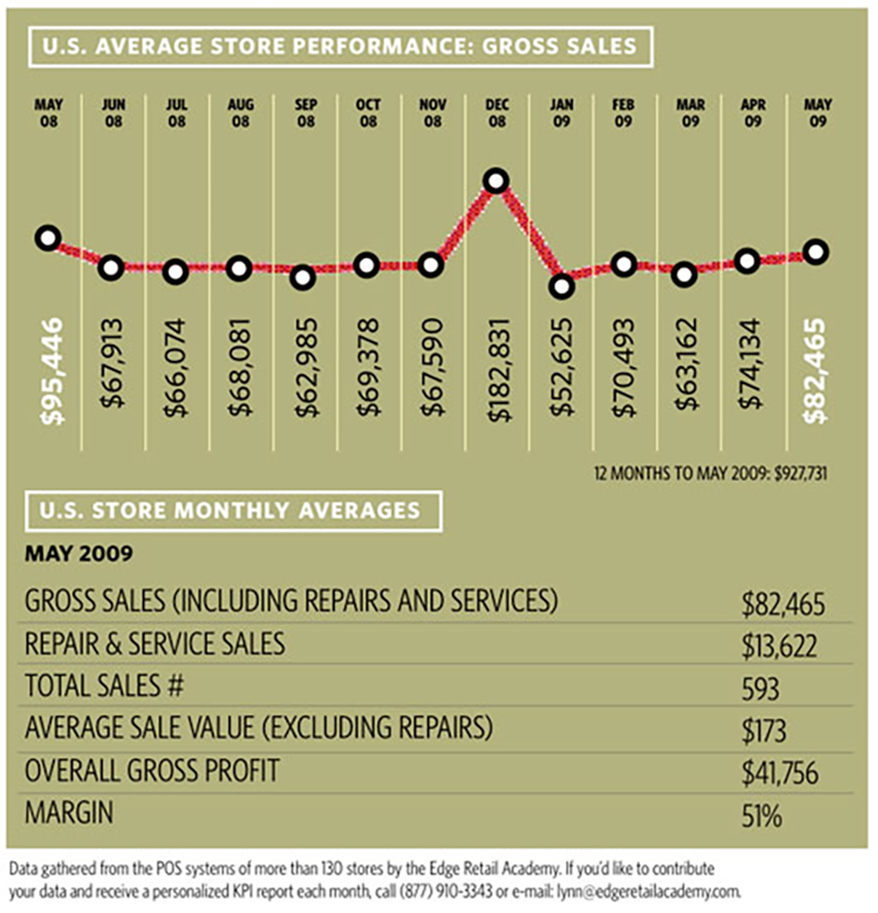THE SAYING “DIAMONDS are forever” may have come from a well known song but it’s a tune that all jewelry store owners should be whistling to themselves on a daily basis if they are looking to put the bite back into their business, says the Edge Retail Academy’s David Brown.
Fashions come and go but throughout history diamonds have been a key part of the jewelry industry. The average retail store in the US generates just under 45 per cent of its revenue from diamond product, and this factor is unlikely to change anytime soon – nor should you want it to. Unfortunately in light of the recession diamond product has taken a heavy hit along with many other consumer products as the graph below illustrates:
As the data shows, the average retail store lost just under $50,000 per annum in diamond sales between July and December of 2008 as consumers looked to purchase lower priced items particularly during the normally lucrative festive season. There has been a gradual climb back up until April but a further drop in May. With times seeming so bleak what can a store owner do to see an improvement in these numbers?
It’s important not to give up on your diamonds. Customers are influenced by what your sales staff show them. Customers may be looking to spend less but don’t assume that. If you show $100 bracelets it gets difficult to then go to a $1,000 diamond ring. Although times are bleak many of your customers are still better off now than they were 12 months ago – they just think they aren’t. Most are still earning the same income and are enjoying the benefit of lower gas prices and mortgage costs. Their house may be worth less but unless they are planning to sell or borrow against it, and most people aren’t, this really isn’t a factor. Average sales across the U.S. jewelry industry have been falling but it would not be unreasonable to assume that a large percentage of this has been caused by the retailer as much as the customer. Jewelry is a “feel good” product and the more they spend, the better they feel. Customers still want the pleasure of retailing, make a decision in your store that if the customer wants to save money they should do it on someone else’s goods — not yours. Let them scrimp on the groceries and cut back on their travel plans. These purchases will be gone in a month anyway. A jewelry item is about emotion not economizing — use this to your advantage during the selling process. Dividing the cost of a diamond across the life of its enjoyment shows it to be one of the most affordable items you can buy so, make sure the customer understands what the item represents to them. They won’t be worrying about what they spent on it in 10 years time.

- Look at your diamond inventory. Is it fresh? Does it say buy me? Is it quality product that you would love for a lifetime if you were buying it? Or is it old, tired and blocking up your windows? Don’t let it sit there and become a poor excuse for what it could be.
- Recognize it as your point of difference. Everyone, from the Internet and drug stores to the corner garage, is eating into the once privileged area of jewelry through selling watches and silver product. But no one sells diamonds with the success of a jeweler. It is about trust. Protect your point of difference and put effort into growing its importance in your store.
- Get that average up. Firstly through making sure your inventory is at the price you need to be selling, and secondly through … well … selling it! Sounds obvious, ,I know, but there are only two ways you will increase your sales. The first is to sell more items. That can be difficult in the current environment but is certainly a strategy every jeweler should have. The second is to sell a dearer item to each person who buys. Ask yourself this question? Which do you think is easier; persuading someone to come into your store to buy or doing something with them once they are in there? It has to be the second, because you have already achieved Step 1 in order to carry out Step 2.
- Talk with your staff. Listen to their attitude. Are they being defeatist about selling diamond product? You need to turn that around through discussing some of the points in this article. They have a huge influence on the consumer, probably more than they realize. If you don’t believe me look at a salesperson report for your staff. Do you have one or two key people who consistently sell more diamond product at a better average than their colleagues? Do they just get lucky with the clients they strike? Would your other staff have achieved the same result if they had made the sale? The answer to both of these is no. Make sure those with the right attitude are dealing with your customers. Statistically up to 60 per cent of jewelry buying is spontaneous — this doesn’t mean you have to leave your odds to chance.
This story is from the August 2009 edition of INSTORE.
Advertisement